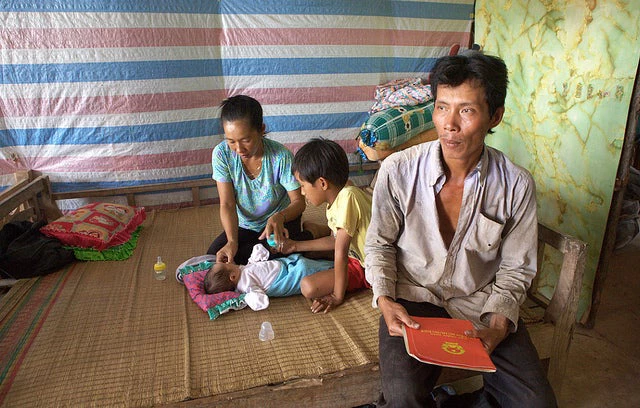
Ground-breaking, far-reaching global guidelines for governments to help them safeguard the rights of people to own or access land , forests, and fisheries were endorsed five years ago by the Committee on World Food Security (CFS), based at the Food and Agriculture Organization of the United Nations (FAO) in Rome.
Today, the Voluntary Guidelines on the Responsible Governance of Tenure (VGGT) are a true global norm of reference in the governance of (land) tenure. The guidelines are pioneering – outlining principles and practices that governments can refer to when making laws and administering land, fisheries, and forests rights. Ultimately, they aim to promote food security and sustainable development by improving secure access to land, fisheries, and forests, as well as protecting the rights of millions of often very poor people.
Sounds simple, maybe even jargony, but no – they are concrete, with real impacts. All of a sudden, we had an internationally negotiated soft law or a set of guidelines on (land) tenure navigating successfully through the global web of interests on land, reaching a common ground. The consensus at the CFS was further strengthened by the endorsement of the VGGT by the G20, Rio+ 20, the United Nations General Assembly, and the Francophone Assembly of Parliamentarians.
[Read: Land Tenure: What have we learned four years after approving a set of international land tenure guidelines? ]
This journey started with an inclusive consultation process started by the FAO in 2009, and finalized through intergovernmental negotiations. Importantly, no interest group – governments, CSOs, academia, private sector – felt left behind, and the States were engaged in word-by-word review of the guidelines.
This can be seen in the result. The VGGT’s power stems from the consensus on its principles that States were to:
- Recognize and respect all legitimate tenure right holders and their rights;
- Protect tenure right holders against the arbitrary loss of their tenure rights; and that
- Women and girls [were to] have equal tenure rights and access to land.
And the list goes on.
VGGT is a consensual recognition that States need to protect “legitimate” tenure rights instead of only “legal” tenure rights. This may not sound like a big difference, however, it is actually key in a world where only about 30% of land rights have been legally recognized.
Those States adhering to the VGGT commit themselves to considering existing land users’ tenure rights, regardless of their legal status, recording, or other. For example, if the VGGT is respected, no blind implementation of land use rights on State lands is possible. The existing users of State lands will need to be recognized, and their rights need to be respected.
The VGGT is also a technical guideline showing pathways to facilitating the enjoyment of legitimate tenure rights, with 10 technical guides to show the way, ranging from gender focus to agricultural investments, forest tenure rights, to registers of rights, and others.
[Read: The Voluntary Guidelines and the World Bank: Increasing Women's Access to Land, Approaches that Work]
A generation of country government decision-makers have been impacted through VGGT policy discussions and initiatives that the FAO has facilitated globally. Awareness of the governance of tenure issue has risen, interaction between governments and CSOs has strengthened, and nobody in the international fora of land and geospatial practices would not have heard of the VGGT and its principles.
Perhaps the one area where the VGGT’s potential has not fully materialized is the VGGT-related investments. In the end, the realization of VGGT principles needs sustained investments to infrastructure and services. The World Bank is engaged in improving land administration in 48 countrie s with approximately $1.1 billion in commitments, and we expect this to grow to $1.6 billion over the next 18 months. In Africa, for example, we are working with governments and partners in the preparation of new land projects in Liberia, Cote d’Ivoire, Tanzania, Mozambique, and Sierra Leone. The latter is an example of VGGT-guided land policy development leading to a project to invest in secure land rights.
What is now needed is a substantial new investment program on improving security of tenure on a mass scale in developing countries. Land and housing are the most important assets of the poor. Improving tenure security for both women and men can have a greater impact on household income, food security, and equity. In support of this, the World Bank is engaging with partners in preparation of a “ Land 2030 Global Initiative” to enhance the commitment of countries and mobilize resources to achieve ambitious targets of securing land and property rights by 2030.
Stay tuned...
This blog post was prepared with contributions by the Land team of the World Bank’s Social, Urban, Rural and Resilience Global Practice.
Related
- Topic brief: Land
- Remarks on the International Land and Forest Tenure Facility
- Blog post: Is there a role for the private sector in managing land registry offices?
- The Voluntary Guidelines and the World Bank: Increasing Women's Access to Land, Approaches that Work
- The Voluntary Guidelines and the World Bank: Implementation of the Forest Rights Act in India: Critical Issues and Learning from Two Case Studies
- The Voluntary Guidelines and the World Bank: Gender Equitable Land Governance in Odisha
- Subscribe to our Sustainable Communities newsletter
- Follow us on Twitter (@WBG_Cities) and Flipboard



Join the Conversation